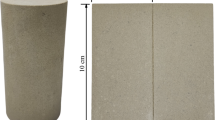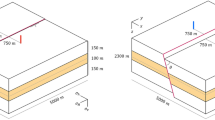Abstract
Shear-wave velocity is a key parameter for calibrating monitoring time-lapse 4D seismic data during CO2-EOR (Enhanced Oil Recovery) and CO2 sequestration. However, actual S-wave velocity data are lacking, especially in 4D data for CO2 sequestration because wells are closed after the CO2 injection and seismic monitoring is continued but no well log data are acquired. When CO2 is injected into a reservoir, the pressure and saturation of the reservoirs change as well as the elastic parameters of the reservoir rocks. We propose a method to predict the S-wave velocity in reservoirs at different pressures and porosities based on the Hertz–Mindlin and Gassmann equations. Because the coordination number is unknown in the Hertz–Mindlin equation, we propose a new method to predict it. Thus, we use data at different CO2 injection stages in the Gao89 well block, Shengli Oilfield. First, the sand and mud beds are separated based on the structural characteristics of the thin sand beds and then the S-wave velocity as a function of reservoir pressure and porosity is calculated. Finally, synthetic seismic seismograms are generated based on the predicted P- and S-wave velocities at different stages of CO2 injection.
Similar content being viewed by others
References
Brown, L. T., 2002, Integration of rock physics and reservoir simulation for the interpretation of time-lapse seismic data at Weyburn Field, Saskatchewan: MSc. Thesis, Colorado School of Mines.
Castagna, J. P., Batzle, M. L., and Eastwood, R. L., 1985, Relationships between compressional-wave and shear wave velocities in clastic rocks: Geophysics, 50(4), 571–581.
Gassmann, F., 1951, Elastic waves through a packing of spheres: Geophysics, 16(4), 673–682
Han, D. H., Nur, A., and Morgan, D., 1986, Effects of porosity and clay content on wave velocities in sandstones: Geophysics, 51(11), 2093–2107.
Kuster, G. T., and Toksöz, M. N., 1974, Velocity and attenuation of seismic waves in two-phase media: Part I. theoretical formulations: Geophysics, 39(5), 587–618.
Lee, M. W., 2003, Velocity ration and its application to predicting velocities: U.S. Geological Survey Bulletin 2197, Denver, Colorado.
Lee, M. W., 2006, A simple method of predicting S-wave velocity: Geophysics, 71(6), 161–164.
Liu, L, Geng, J. H., and Guo, T. L., 2011, The bound weighted average method (BWAM) for predicting S-wave velocity: Applied Geophysics, 9(4), 421–428.
Liu, Y. J., Li, Sh. J., Wang, Y. G., and Xia, Y. H., 2016, Reservoir prediction based on shear wave in Sulige Gas Field: China. Oil Geophysical Proepecting, 51(1), 165–173.
Luo, H. M., Luo, X. R., Liu, S. H., et al., 2014, Physical features and influencing factors of elastic velocity of compacted sandy-conglomerates in northern steep slope, Dongying sag: Petroleum Geology and Recovery Efficiency, 21(2), 91–94.
Luo, S. L., Yang, P. J., Hu, G. M., et al., 2016, S-wave velocity prediction based on the modified P-L model and matrix equation iteration: Chinese J. Geophys, 59(5), 1839–1848.
Mavko, G., Mukerji, T., and Dvorkin, J. P., 1998, The Rock Physics Handbook: Cambridge University Press, 51–52.
Ma, J., Li, L., Wang, H., et al., 2016, Geophysical monitoring technology for CO2 sequestration: Applied Geophysics, 13(2), 288–306.
Mindlin, R. D., 1949, Compliance of elastic bodies in contact: Journal of Applied Mechanics, 16, 259–268.
Murphy, W., 1982, Effects of microstructure and pore fluids on the acoustic properties of granular sedimentary materials: PhD Thesis, Stanford University.
Pride, S. R., Berryman, J. G., and Harris, J. M., 2004, Seismic attenuation due to wave-induced flow: Journal of Geophysical Research, 109, B01201.
Qiu, G. Q., Ling Y., and Fan, H. H., 2003, The characteristics and distribution of abnormal pressure in the Paleogene source rocks of Dongying Sag: Petroleum Exploration and Development, 30(3), 71–75.
Shi, H., 2008, Numerical simulation research on parameter optimization of CO2 miscible flooding of Gao89-1 Block in Zheng Lizhuang Oil field: Offshore Oil, 28(1), 68–73.
Tan, M. Y., Zhang, J. N., and Xu, L., 2004, Prediction method of formation pressure in Jiyuan Depression: Oil Geophysical Prospecting, 39(3), 314–318.
Walton, K., 1987, The effective elastic moduli of a random packing of spheres: Journal of the Mechanics and Physics of Solids, 35(2), 213–226.
Winkler, K. W., 1983, Contact stiffness in granular and porous materials: comparison between theory and experiment: Geophysical Research Letter, 10, 1073–1076.
Wood, A. W., 1955, A textbook of sound: The MacMillan Co., New York.
Xu, S., and White, R. E., 1995, A new velocity model for clay-sand mixtures: Geophysical Prospecting, 43(1), 91–118.
Xu, S., and Payne, M. A., 2009, Modeling elastic properties in carbonate rocks: The Leading Edge, 28, 66–74.
Zhu, C., Guo, Q. X., Gong, Q. S., Liu, Z. G., Li, S. M., and Huang, G. P., 2015, Prestack forward modeling of tight reservoirs based on Xu-White model: Applied Geophysics, 12(3), 389–399.
Acknowledgements
We wish to thank the staff of the Geophysical Research Institute of SINOPEC Shengli Oilfield for their cooperation and support. The authors are particularly grateful to Professor Huang Xuri and Chen Xiaohong for their guidance and comments.
Author information
Authors and Affiliations
Corresponding author
Additional information
This work was supported by the National High Techology Research and Development Program (No. 2012AA050103).
Li Lin is a PhD candidate in Geophysics at the Department of Geology, Northwest University, China. Her research interests are rock physics modeling, AVO analysis, and time-lapse seismic monitoring for CO2 sequestration.
Rights and permissions
About this article
Cite this article
Li, L., Ma, JF., Wang, HF. et al. Shear wave velocity prediction during CO2-EOR and sequestration in the Gao89 well block of the Shengli Oilfield. Appl. Geophys. 14, 372–380 (2017). https://doi.org/10.1007/s11770-017-0638-5
Received:
Revised:
Published:
Issue Date:
DOI: https://doi.org/10.1007/s11770-017-0638-5




